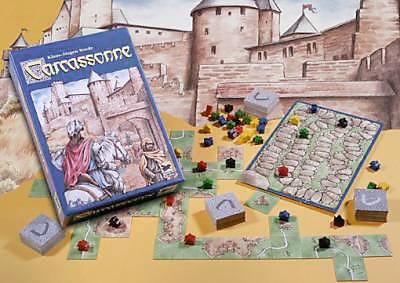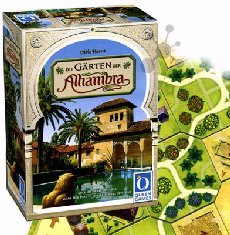Falelorn
Shared on Mon, 01/15/2007 - 03:08Settlers of Catan
From Wikipedia http://en.wikipedia.org/wiki/Settlers_of_Catan
Settlers of Catan is a multiplayer board game invented by Klaus Teuber, first published in 1995 in Germany by Franckh-Kosmos Verlags-GmbH & Co. (Kosmos) under the name Die Siedler von Catan.
Settlers is perhaps the first German-style board game to reach any degree of popularity outside of Europe. It has been translated into Chinese, Czech, Danish, Dutch, English, Estonian, Finnish, French, Greek, Hungarian, Italian, Icelandic, Japanese, Korean, Latvian, Lithuanian, Norwegian, Polish, Portuguese, Romanian, Russian, Slovenian, Spanish, Swedish, and Turkish from the original German. The standard game and its many expansions are available from Mayfair Games in the United States, from Capcom in Japan, Kosmos and 999 Games in the European Union, and Devir in Brazil. Computerized versions also exist for the PC and mobile devices such as the Nokia N-Gage. Also, Microsoft recently announced at the August 2006 Leipzig games convention that a version of Settlers will soon be available on Xbox Live Arcade for the Xbox 360 along with other German board game adaptations.
Teuber's original design was for a large game of exploration and development in a new land. Between 1993 and 1995 Teuber and Kosmos refined and simplified the game into its current form. Unused mechanics from that design went on to be used in Teuber's following games, Entdecker and Löwenherz. The game's first expansion, Seafarers of Catan, adds the concept of exploration, and the combined game (sometimes known as "New Shores") is probably the closest game to Teuber's original intentions.
Carcassonne
From wikipedia http://en.wikipedia.org/wiki/Carcassonne_%28board_game%29
Carcassonne is a tile-based German-style board game for two to five players, designed by Klaus-Jürgen Wrede and published in 2000 by Hans im Glück in German and Rio Grande Games in English. It received the Spiel des Jahres award in 2001. It is named after the medieval fortified town of Carcassonne in southern France, famed for its city walls. The game has spawned many expansions and spinoffs, inspired several PC and console versions, and the wooden follower pieces from the basic game (colloquially called meeples, a portmanteau of my people[1]) have become a symbol of European board gaming.
Gameplay
The game board is a medieval landscape built by the players as the game progresses. The game starts with a single terrain tile face up and 71 others shuffled face down for the players to draw from. On each turn a player draws a new terrain tile and places it adjacent to tiles that are already face up. The new tile must be placed in a way that extends features on the tiles it abuts: roads must connect to roads, fields to fields, and city walls to city walls.
After placing the new tile, the placing player may opt to station a follower piece on that tile. The follower can only be placed on the just-placed tile, and must be placed in a specific feature. A follower claims ownership of one terrain feature - road, field, city, or cloister - and may not be placed on a feature already claimed by another player's follower. However, it is possible for terrain features to become shared after the further placement of tiles. For example, two field tiles which each have a follower can become connected into a single field by another terrain tile.
The game ends when the last tile has been placed. At that time all features (including fields) score points for the players with the most followers in them. The player with the most points wins the game.

Alhambra
from Wikipedia http://en.wikipedia.org/wiki/Alhambra_%28game%29
Alhambra is a tile-based German-style board game designed by Dirk Henn and published Überplay and Queen Games in 2003. The game is an Arabian-themed update of the 1998 stock trading board game Stimmt So!, which in turn was an update of the 1992 mafia influence board game Al Capone.
In 2003, Alhambra won the Spiel des Jahres award, the Schweizer Spielepreis for Family Games, the As d'Or and the Essen Feather, and placed 2nd in the Deutscher Spiele Preis.
Gameplay
The game consists of a deck of currency cards of various values in four currencies (suits) and a bag of building tiles of various prices, as well as a number of boards (a currency market, a building market, a reserve board for each player and a scoring track). Six of the building tiles are Alhambra tiles; these are taken out of the bag and one is given to each player. Each player is then dealt currency cards until the total value of cards in their hand is greater than or equal to twenty. The currency cards are shuffled into five piles, and the two special scoring cards are inserted into the second and fourth piles. The five piles are then placed in order to form the currency deck. Four currency cards are drawn and placed on the currency market, and four building tiles are drawn and placed on the four spaces of the building market. The set of tiles connected to a player's Alhambra tile is called their Alhambra.
Players then take turns, during which they may perform one of the following actions:
- Draw currency cards - either one card of any value or multiple cards totalling five or less.
- Buy building tiles - by discarding currency cards totalling the value of the tile or greater. Each space on the building market has a currency type next to it; all cards discarded must be of that suit. If the value of cards discarded exactly equals the price of the tile, the player gets another go. Cards must be placed in the reserve board or attached to their Alhambra.
- Move a building tile - either from their reserve board to their Alhambra, from their Alhambra to their reserve board, or from one position in their Alhambra to another.
Currency cards and Building tiles are then added to any spaces on the Currency market or the Building market.
Some tiles have walls along one or more edges. When players add tiles to their Alhambra, it must be possible to trace a path from the tile to the fountain at the centre of the Alhambra tile, remaining within tiles and without crossing any walls.
When the scoring cards are drawn from the Currency deck, or when the there are fewer than four buildings remaining to be sold, scoring occurs. The player with the most of a given building card type scores points according to that type; in case of a tie, points are split between players. Less common building types are worth more points, and building types are worth more points in later scoring rounds. In the final scoring round, the player with the most of a given currency type takes the tile of that currency type and may add it to their Alhambra before scoring, and the player with the longest wall segment scores one point for each segment.

Who is making each game?
What will they look like?
What features?
Damn near impossible to find any info, other then the original press release.. But at least no cancellation press releases..
- Falelorn's blog
- Log in or register to post comments


Comments
Submitted by KingDrewsky on Mon, 01/15/2007 - 10:30